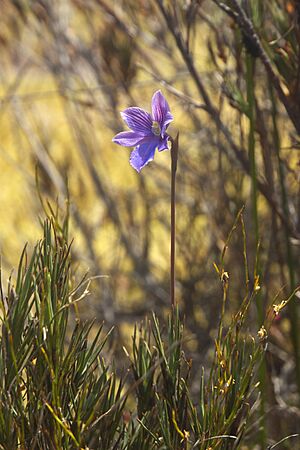Veined sun orchid facts for kids
Quick facts for kids Veined sun orchid |
|
|---|---|
 |
|
| Thelymitra cyanea in Mount Buffalo National Park | |
| Conservation status | |
| Scientific classification | |
| Genus: |
Thelymitra
|
| Species: |
cyanea
|
| Synonyms | |
The Thelymitra cyanea, often called the veined sun orchid in Australia and the swamp sun orchid or striped sun orchid in New Zealand, is a type of orchid. This plant grows naturally in New Zealand and south-eastern Australia. It has one upright, thick leaf and up to five bright blue flowers. These flowers have darker blue lines, like veins. You can usually find this orchid growing in wet areas. This includes swamps, sphagnum bogs, and high mountain grasslands. They often grow in groups that are all connected, like a big family.
Contents
What the Veined Sun Orchid Looks Like
The Veined Sun Orchid is a plant that grows from a tuber (a swollen underground stem). It is a perennial herb, meaning it lives for more than two years and has soft stems. It has one upright, thick leaf that is shaped like a channel. This leaf is about 150 to 250 millimeters (6 to 10 inches) long and 5 to 7 millimeters (0.2 to 0.3 inches) wide.
Up to five bright blue flowers grow on a stem that is 200 to 400 millimeters (8 to 16 inches) tall. These flowers have darker blue lines and are 20 to 30 millimeters (0.8 to 1.2 inches) wide. The flowering stem usually has two bracts, which are small, leaf-like parts.
The sepals and petals of the flower are about 12 to 16 millimeters (0.5 to 0.6 inches) long and 8 to 10 millimeters (0.3 to 0.4 inches) wide. The labellum, which is the lowest petal, is bigger than the other petals and sepals. The central part of the flower, called the column, is white to light blue. It is about 4 to 6 millimeters (0.16 to 0.24 inches) long and 3 millimeters (0.12 inches) wide. The side parts of the column are yellow and have a twisted or toothed tip.
These flowers often pollinate themselves. They open up on warm, sunny days. You can see them flowering from November to March.

How the Veined Sun Orchid Got Its Name
The Veined Sun Orchid was first officially described in 1840 by a person named John Lindley. He first gave it the name Macdonaldia cyanea. This description was written in his book, A Sketch of the Vegetation of the Swan River Colony.
Later, in 1873, George Bentham changed the name to Thelymitra cyanea. He published this change in his book, Flora Australiensis. The second part of its scientific name, cyanea, comes from an Ancient Greek word. The word kyanos means "dark blue," which perfectly describes the flower's color.
Where the Veined Sun Orchid Lives
The Thelymitra cyanea is found in many places and is often common. It grows in south-eastern Australia and New Zealand. It likes to live in damp or very wet, boggy areas. You will mostly find it in mountain and subalpine (just below the tree line) habitats.
In New Zealand, it is widespread on the North, South, and Chatham Islands. In New South Wales, Australia, it grows on the tablelands south of Ebor. You can also find it in south-eastern Victoria and in Tasmania. In South Australia, it is only found near Mount Compass.
Conservation Status
Even though this orchid is common in many places, it is listed as "endangered" in South Australia. This is because most of the places where it used to grow have been drained. These areas are now used for farming.
See also
 In Spanish: Thelymitra cyanea para niños
In Spanish: Thelymitra cyanea para niños


